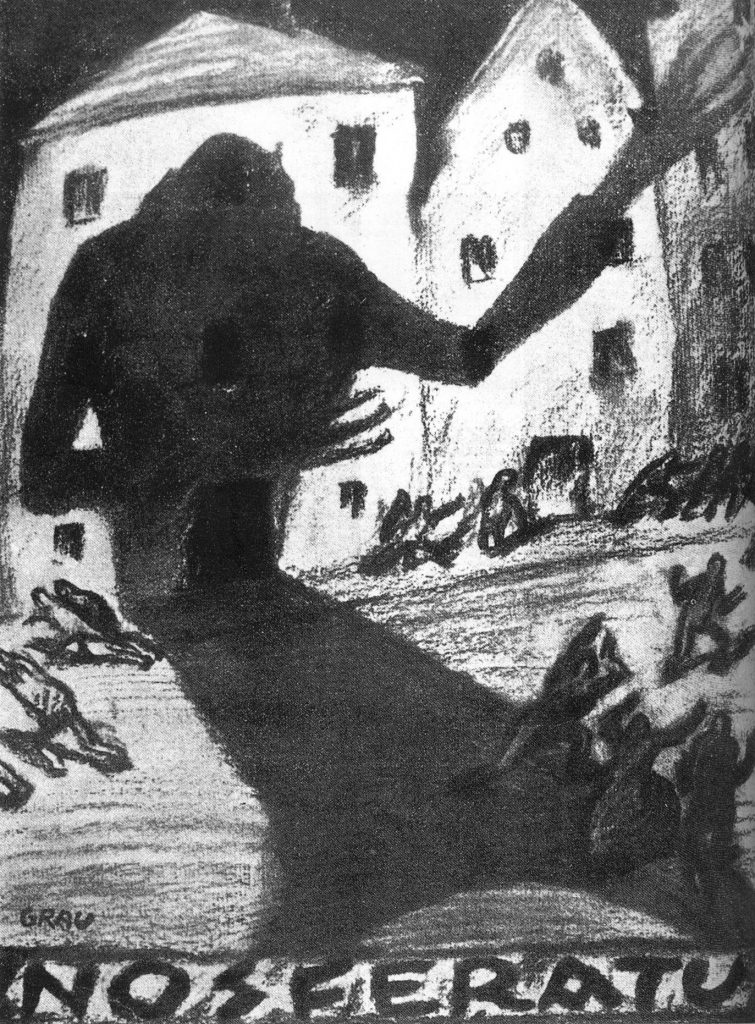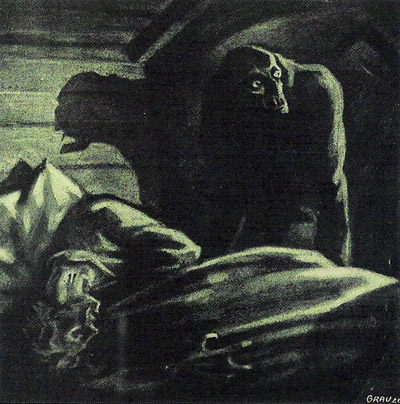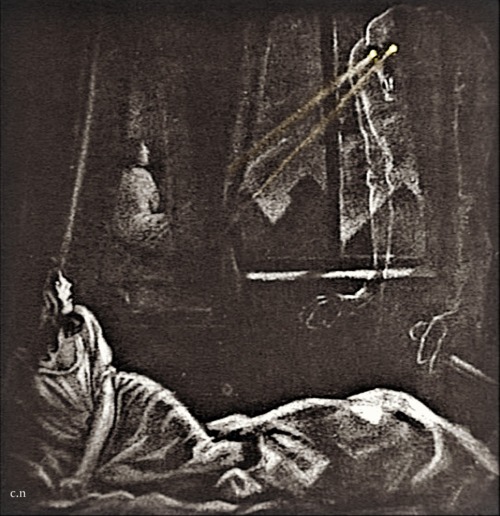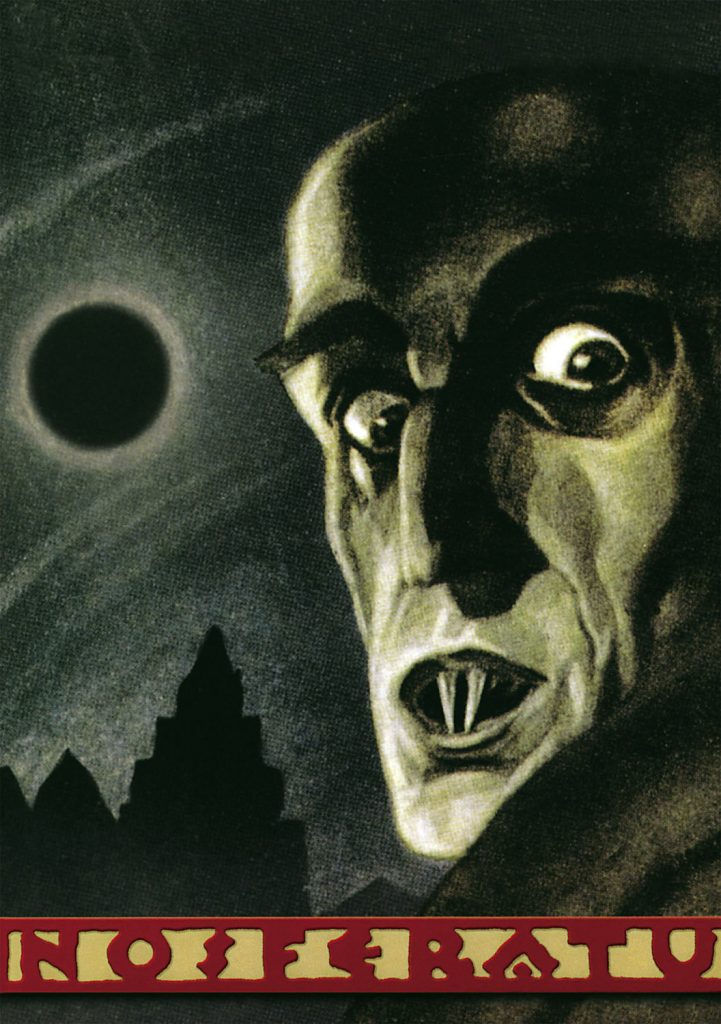On the Way to Nosferatu: Presentation of a Reconstruction by Enno Patalas
- Helmed by iconic director Friedrich Wilhelm Murnau, one of the key works of the entire silent era
- Both have inspired – then as now – an unending supply of texts from fans and scholars alike
- First of a selection of important vintage articles on the history of this landmark horror
- Further recommended resources to decipher what drives the mysterious count
This is part of a series of articles covering everything Graf Orlok and best read sequentially. They detail the film’s history, many different versions and home video releases, and I suggest you start reading from Part 1, unless you want to skip straight to the restored DVD and Blu-ray reviews.
Here is an important vintage essay reprinted verbatim, though it has been slightly edited for grammar lost in translation. While being an invaluable reference, note it’s occasionally a little outdated. Refer to the aforementioned guide for the latest info.

Painting by Dave Stevens (1955–2008)
Contents
Introduction
Murnau’s Nosferatu was never a ‘lost film’. Unlike Der Gang in die Nacht (Journey into the Night, 1920), Phantom (1922), Die Finanzen des Großherzogs (The Finances of the Grand Duke, 1923) and Der brennende Acker (Burning Earth, 1922), Nosferatu has always been with us, in various different forms. This is largely thanks to Henri Langlois and the Cinémathèque Française, who preserved a copy of the second French version, dated 1926 or 1927. This version contained the famous title which had so delighted André Breton [in his book Les Vases communicants aka Communicating Vessels, 1932]: “Et quand il fut de l’autre côté du pont, les fantômes vinrent à sa rencontre” [And when he was on the other side of the bridge, the phantoms came to meet him]. It could be seen as an admittedly free but by no means inappropriate translation of the original German text: “Kaum hatte Hutter die Brücke überschritten, da ergriffen ihn die unheimlichen Gesichte…” [Barely had Hutter crossed the bridge, than he was seized by the uncanny visions…]
Intertitles
It was a print from this version that reached the New York Museum of Modern Art in 1947. There, as was the norm in [then-director] Iris Barry’s time, the foreign-language intertitles were translated into English. In the process, the names of the characters (which in the French version had roughly approximated the German names) were changed to the names of the characters in Bram Stoker’s Dracula, which the film is of course based on. In this it followed the first American version of the film. Orlok thus became Dracula, Hutter became Jonathan Harker, Knock (who had been Knox in the French version) – Renfield, Bulwer – Van Helsing…, and Wisborg became Bremen.
This is the form in which the film returned to Europe, first to London and the National Film Archive and thence to Germany, to a distribution company which was, in the 1960s, performing a valuable role in making Weimar cinema available to a wider public. This company translated the English titles back into German, retaining the altered names. When copies were needed for export into Francophone countries they translated the German titles (which had been translated from the English titles, which themselves had been translated from the French) back into French. The film is still shown in this form in Goethe Institutes in Montreal, Brussels, Toulouse and Paris. The descriptions of the film to be found in issue no. 228, 1979, of l’Avant-Scène: Cinéma and in Michel Bouvier and Jean-Louis Leutrat’s 1981 book, Nosferatu, are also based on this version. At the same time the graphic form of the intertitles was standardised from one version to the next, and there was a loss in image quality down the generations.
There is a story (I do not know whether it is true) that Henri Langlois used to remove the intertitles from prints of silent films. What is certain is that he was not very interested in preserving or restoring them. This was in marked contrast to Lotte H. Eisner, who was aware of the importance of titles, at least in German films of the 1920s, and who inspired me, 20 years ago, to begin searching for the titles of Der müde Tod (The Tired Death aka Destiny, 1921) and also Nosferatu, which were thought lost. The evidence of the script and title-list from Murnau’s estate, which Lotte had secured for the Cinémathèque Française, and which are reproduced in facsimile in the appendix to the German edition of her 1964 book on Murnau, suggested that such a search might be worthwhile. From them we discovered that in the known prints, of French provenance, a sixth of the intertitles were missing (16 out of the original 97, not counting the 19 act divisions and opening and closing credit titles), and that many of the remaining titles differed greatly from the original text. We also discovered that writing in the film had originally had a far greater importance than the French version and its descendants had suggested.
This was true not only of Nosferatu but also of Der müde Tod, Das Cabinet des Dr. Caligari (The Cabinet of Dr. Caligari, 1920), Der Golem, wie er in die Welt kam (The Golem: How He Came into the World, 1920) and Dr. Mabuse, der Spieler (Dr. Mabuse the Gambler, 1922). In the most important German films of the early 1920s, intertitles did not serve only as headings and to convey dialogue. The Caligari titles, painted by Hermann Warm, are a continuation of the sets, also designed by Warm, while, working the other way round, painted words (“You must become Caligari!”) suddenly appear in the sets. In Der müde Tod the graphic style of the intertitles (which I found as flash titles in a print in the Moscow archive) are related to the place, time and background story of the three episodes. The Golem titles bear the signature of the designer of the ghetto sets, Hans Poelzig.
In Nosferatu the action was linked to three books: to the ‘diary’, a kind of chronicle of the plague, whence the action initially emerges and into which it finally returns; secondly, to the vampire book that Hutter finds in the Carpathian inn, just as one might find a Bible in a hotel room today, which shows him and his wife their future; and, finally, to the ghost-ship’s log book. In these books the action never simply moves on. Rather, the books edge what is seen and shown into a shadowy half-light, from both the characters’ and the viewer’s points of view. There are, in addition, letters, a page from a newspaper and various official documents.
The well-known French version and those based on it ascribed the ‘diary’ to Johann Carvallius or Cavallius, “ancien magistrat et habile historien de sa ville natale” [former magistrate and skilful historian of his hometown]. In Murnau’s title-list, on the other hand, the keeper of the diary is anonymous, without fame or title. His signature is three crosses (“three properly painted graveyard crosses” are specified in the title-list) – a voice from beyond the grave. This was obviously too irrational for whoever put together the French version.
The greatest works of the German cinema of the early 1920s almost without exception make reference to ‘author-less’ literary genres, traditional or modern: to anonymous testimonies and traditions, to folk tales, legends, books of magic, chronicles, crime novels and science fiction, but almost never to the work of well-known writers. Fritz Lang made no distinction between filming a story from a newspaper serial such as Dr. Mabuse or a saga like Die Nibelungen (1924), and when Murnau was shooting his Faust – Eine deutsche Volkssage (Faust – a German Folktale, 1926), he followed not Goethe but the medieval folk epic. The anonymity of the storyteller, his voice from beyond the grave, is not the only pointer in Nosferatu signalling the disintegration of the bourgeois author and the bourgeois hero. The storyteller who signs his work with three graveyard crosses matches the vampirical Count, who finally disappears in a puff of smoke, a creature somewhere between human and animal, between life and death, a hermaphrodite like the flesh-eating plant with which he is compared in the film. (And Ellen, in the first dialogue title of the film, talks of the flowers Hutter has picked for her as though they were living beings: “Why have you killed them..?” she asks. Again, it is certainly no coincidence that this title is among those deleted in the French version.)
It is therefore not a sign of inconsistency when Murnau, having used 116 intertitles in seven different forms in Nosferatu, then, inspired by Carl Mayer, followed the example of Scherben (Shards aka Shattered, 1921) and Sylvester (New Year’s Eve, 1923) and made Der letzte Mann (The Last Man aka The Last Laugh, 1924) almost without titles, explaining that the ideal film is one without any intertitles whatsoever. The proliferation of non-literary, pre-literary, popular and anonymous forms of speech and writing already goes some way towards dissolving the link between cinema and literature, the most sustained expression of this effect being the title-less film which rests entirely on the image.
The significance of the intertitles of the original Nosferatu is evidenced by the title-list, but is illustrated even more clearly in a print preserved in the Staatliche Filmarchiv der DDR (the GDR State Film Archive) which was made available to the Münchner Filmmuseum in 1980 for our first attempt at a reconstruction. Albin Grau, who was also responsible for the sets and costumes, had done the lettering. They are like shot set-ups within the film proper, and fade in and out. Pages are turned.
This print from the GDR Archive was no more than a skeleton, but it did contain most of the titles and at least examples of almost all types of titles and inserts occurring in the film, credit and dialogue titles, the diary, the vampire book, the log book, letters, etc. Only the titles indicating the start and end of acts were missing. This print enabled us, in the 1980s, to make new prints of the titles, or to letter them ourselves in a faithful copy of the original, or to put together and then film the background elements with their text.
Also in 1980 [archivist] Mary Meerson made available to us another version of Nosferatu from the holdings of the Cinémathèque. It was again Lotte H. Eisner who had alerted the world to the existence of this version in an article for the January 1958 issue of Cahiers du Cinéma (Notebooks on Cinema) entitled L’Enigme des deux Nosferatu (The Enigma of the Two Nosferatus). It was about a version with the title Die zwölfte Stunde (The Twelfth Hour), which a certain Dr. Waldemar Roger had assembled in 1930 with the intention of releasing it with sound – not optical sound but ‘stylus-sound’, i.e. a combination of film and gramophone record. This version contained a series of [newly filmed] additions, mostly designed to provide visual justification for the use of music. Many parts were changed around in order to give the film a happy ending, for example. Again and again sequences and single shots had been shortened. The intertitles were completely new and quite different. [The first version of the censorship card B 27446 is reproduced in Lotte H. Eisner’s F.W. Murnau (1964, Eng. 1973).]
There are, however, long sections where this re-edit has obviously left the original shot sequence untouched. This provided us with several shots that we had previously known in either abbreviated versions or in poor condition or indeed had not known at all. These we could now add into the reconstruction.
Colour
Intertitles are not the only aspect of 1920s cinema which was neglected, if not actually despised, by the post-war generation of cinephiles: colour is another. They came to know and love the cinema of this era in the black-and-white prints via which it was handed down to them. This was, of course, in a period when the passage from black-and-white to colour was as controversial as the change from silent to sound film had been twenty years earlier.
The Cinémathèque print of the second French version of Nosferatu was black-and-white, as were all the prints made from it, as well as those preserved in East Berlin, and also Die zwölfte Stunde.
Nosferatu must have been in colour at the time of its release in 1922: ‘tinted’ and perhaps also ‘toned’. We make this assumption not only because this was normal in Germany at the time, but also because a vampire does not walk around in broad daylight, as he does in all the black-and-white prints of the film. A definite indication that Nosferatu was intended to be coloured was found in Act five of the film. In the shot where the wind blows a candle out, in this exact place, there was a splice, demonstrating that the sections before and after had been printed separately, the first to be coloured yellow or orange for candle-light and the second blue or green, for night and moonlight.
We do not know, unfortunately, how much influence Murnau exerted on the colouring of his films. I only remember one note, in his handwriting, in the script of Schloss Vogelöd (Castle Vogeloed, 1921), saying, “Leave the dream scenes black-and-white.” (Strangely, the relevant page has in the meantime disappeared from the script preserved in the Bibliothèque du Film.) He obviously left the rest of the colouring to the laboratory staff making the prints.
The original intertitles also indicate that Nosferatu was very much conceived as a day-and-night film. At the beginning of the film every change in the time of day is announced by a title (“… at last the Carpathian peaks lit up before him”, “Hurry, the sun is setting!”, “As soon as the sun rose, the terrors of the night left Hutter…”), followed by a twilight image – a mountain view, clouds or seascapes, always without people. Later in the film the twilight images function alone, without introductory titles, to mark the change from day to night and vice versa.
In the mid-1980s Luciano Berriatúa of the Filmoteca Española, an eminent Murnau scholar, found another print of Nosferatu in the depths of the Cinémathèque vaults, a print which even Lotte H. Eisner herself had obviously failed to find. It was a coloured copy of the first (1922) French version of the film (about which Robert Desnos had written long before Breton had noted the film). [In various journals, published 6.4.23, 31.1.25 and 5.3.27; collected in Les Rayons et les ombres: Cinéma aka The Rays and the Shadows: Cinema, 1992.] Parts of the film were missing, due to deliberate cuts by the distribution company as well as normal wear and tear on the print, and the colours had altered considerably. The blue of the night scenes had disappeared completely, and [the] Nosferatu was again walking in the sunshine. Nevertheless, it was still possible to see which colour had been allocated to each section. We could also tell that the French distributor had, as was normal at the time, received the coloured positive print from Germany, producing only the French titles in France. One could therefore assume that the French version was based on the same colouring plan as the German version.
This made it obvious that night scenes had sometimes been coloured blue and green, even when a lamp was visible as the light source and one would therefore have expected yellow. In the scene at the Carpathian inn in act one, blue exterior shots alternate with yellow interiors, as was the convention at the time, but in the scenes in Hutter and Ellen’s apartment in the final act, when Nosferatu is sucking Ellen’s blood, blue exteriors alternate with green interiors. Green, alternating with blue, underlines the eeriness of these scenes, which suggests that when Hitchcock was deciding on the colouring for The Lodger (1927) he remembered the music-hall melodramas he saw as a child, where the villain was always bathed in green light. Twilight images in Nosferatu were originally coloured pink as a rule, with only one, the shot with the flesh-eating plant, the venus fly-trap, coloured orange.
Assembly
In 1994 the Cineteca del Comune di Bologna undertook, in the context of the European Community’s Lumière Project, to continue the reconstruction which had begun in Munich. First, a black-and-white negative was printed from the Paris colour print on to panchromatic stock. All missing, incomplete or damaged shots were replaced from the two other nitrate prints in the Cinémathèque Française, a nitrate dupe negative of the second French version and a nitrate positive print of Die zwölfte Stunde. A colour positive print was struck from this black-and-white negative using the method developed by Noël Desmet at the Cinémathèque Royale de Belgique: “A neutral black-and-white image is first struck from a black-and-white negative and printed on to a positive colour emulsion…; this image is then exposed, without negative, to the desired colour by flashing coloured light on to it. The result is a black-and-white image on a tinted background.”
In addition to the 522 shots of the well-known version, not including titles and inserts, a further thirty gradually found their way into the reconstruction. Most are single shots or, more rarely, two or three within a sequence. Only in one place is there a short sequence of five new shots together (in a scene with Harding and Ruth playing croquet). Other shots are now longer and fade in and out where there had previously been ‘hard’ cuts, or the image quality has been improved. An extra 400 metres has been added to the 1,562 metres of the well-known version, so that no more shots should now be missing from the original 1,967 metres length.
Music
Even more of a bête noire to old-school film-buffs than the colouring and toning of prints is the practice of presenting them with musical accompaniment. Henri Langlois was not, it seems, always dedicated to showing ‘silent films’ silent, and in the early days he would have Joseph Kosma accompany them on the piano. Certainly, musical accompaniments in the silent film era were normally an element in bringing a film to the people rather than a part of the film’s artistic creation, and it took a new interest in this aspect of cinema history, a desire to look beyond auteur theory, to persuade film archives and cinémathèques to start concerning themselves with the music. There are, however, indications that directors such as Lang and Murnau were no more indifferent to the musical accompaniment than they were to the colour or indeed to any part of the technical aspect of their films.
We discover from the title-list handed down by Lotte H. Eisner that the credits of the original Nosferatu give Hans Erdmann as the composer of the original music for the film, just as the Nibelungen and Metropolis (1927) title-lists name Gottfried Huppertz. Erdmann was a conductor, composer and music critic and from 1926 edited the journal Film-Ton-Kunst (Film-Sound-Art). In 1927, together with Giuseppe Becce, he published the Allgemeines Handbuch der Film-Musik (General Manual of Film Music). In 1932 he wrote the music for Fritz Lang’s Testament des Dr. Mabuse (1933).
Erdmann and Becce have reported that before completing his films, Murnau used to discuss the music with the composers. Erdmann composed his Nosferatu score as a suite which he called Fantastisch-Romantische Suite. It was published in two arrangements, one for full orchestra and one for palm court orchestra. The score contains ten titles: Idyllic, Lyrical, Ghostly, Stormy, Destroyed, Strange, Grotesque, Unchained, Distraught. None of the ten pieces, wrote Erdmann in an open letter to an orchestra director who had attacked the composition as “too highbrow”, was “planned in such a way that it must always be used in the form provided. It is of course possible to do so, but by no means obligatory.” The suite was used in the cinemas of Berlin “with varying degrees of success. Sometimes very good effects were produced, but in other cases the results were less satisfactory.”
I finally heard this music, arranged by the Berlin musicologist Berndt Heller and played by the DEFA Symphony Orchestra (now called the Babelsberg Film Orchestra), during a presentation of the film in a church in Neu-Ruppin in the Brandenburg Marches. What struck both Heller and myself, completely independently, was how the musical and colouring effects reinforced each other.
—————————————
 Leading German film historian and preservationist Enno Patalas (1929–2018) was director of the Munich Film Museum from 1973–1994 and oversaw the restoration of numerous German classics, particularly the work of directors like Fritz Lang , Ernst Lubitsch , Georg Wilhelm Pabst and F. W. Murnau. He was married to film critic and essayist Frieda Grafe (1934–2002). This essay, in a much shorter form, was originally written as a letter to Lotte H. Eisner (1896–1983) at the time of the second restoration and titled Nosferatu will nicht sterben (Nosferatu Will Not Die). It’s reproduced here, in Film-Korrespondenz (bi-weekly, 1955-1990) nos. 5/6, 13.3.1984, and in F. W. Murnau: Nosferatu (ed. Fritz Göttler, 1987). The version published on this site, updated to include the 1995 restoration, also appears in:
Leading German film historian and preservationist Enno Patalas (1929–2018) was director of the Munich Film Museum from 1973–1994 and oversaw the restoration of numerous German classics, particularly the work of directors like Fritz Lang , Ernst Lubitsch , Georg Wilhelm Pabst and F. W. Murnau. He was married to film critic and essayist Frieda Grafe (1934–2002). This essay, in a much shorter form, was originally written as a letter to Lotte H. Eisner (1896–1983) at the time of the second restoration and titled Nosferatu will nicht sterben (Nosferatu Will Not Die). It’s reproduced here, in Film-Korrespondenz (bi-weekly, 1955-1990) nos. 5/6, 13.3.1984, and in F. W. Murnau: Nosferatu (ed. Fritz Göttler, 1987). The version published on this site, updated to include the 1995 restoration, also appears in:
- The European Film Archives at the Crossroads: The Lumière Project (ed: Catherine A. Surowiec, 1996)
- Filmblatt (Film Sheet), vol. 7, no. 18, Winter/Spring 2002
- Film History: An International Journal, vol. 14, no. 1, 2002
- UK Eureka/Masters of Cinema Nosferatu DVD/Blu-ray booklet, 2007/2013
Another equally informative Nosferatu-related essay by Patalas, though much broader in scope:
- On “Wild” Film Restoration, or Running a Minor Cinematheque – Journal of Film Preservation no. 56, June 1998
Nosferatu: Chronicles from the Vaults: Volume II
Related articles
This is part of a unique series of articles covering everything Graf Orlok.







